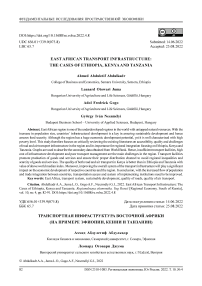East African transport infrastructure: the cases of Ethiopia, Kenya and Tanzania
Автор: Abdulkadr Ahmed Abduletif, Juma Leanard Otowari, Gogo Adol Fredrick, Neszmlyi Gyrgy Ivn
Журнал: Региональная экономика. Юг России @re-volsu
Рубрика: Фундаментальные исследования пространственной экономики
Статья в выпуске: 4 т.10, 2022 года.
Бесплатный доступ
East African region is one of the underdeveloped regions in the world with untapped natural resources. With the increase in population size, countries’ infrastructural development is a key in assuring sustainable development and hence assures food security. Although the region has a huge economic development potential, yet it is well characterized with high povertylevel. This studytherefore focuses on critically reviewing the existing literatures on accessibility, quality and challenges ofroad and air transport infrastructure in the region and its importance for regional integration focusing on Ethiopia, Kenya and Tanzania. Graphs are used todescribe the secondarydata obtained from World Bank. Hence, insufficient transport facilities, high cost of infrastructure development and poor transport management are the main challenges in the region. Transport facilities promote production of goods and services and ensure their proper distribution channel to avoid regional inequalities and scarcityofgoods and services. The qualityof both road and air transport in Kenya is better than in Ethiopia and Tanzania with value of above world median index. Moreover, improving the overall system of the transport infrastructure will playa significant impact on the economic development of respective countries and the region. In conclusion, with the increased flow ofpopulation and trade integration between countries, transportation access and system of implementing institutions need to be improved.
East africa, transport system, sustainable development, quality of roads, quality of air transport
Короткий адрес: https://sciup.org/149141741
IDR: 149141741 | УДК: 656.01+339.9(075.8) | DOI: 10.15688/re.volsu.2022.4.8
Текст научной статьи East African transport infrastructure: the cases of Ethiopia, Kenya and Tanzania
DOI:
Infrastructure has been defined in many ways by several scholars. For example, J. Eynon [Eynon, 2016] defined infrastructure as basic physical and organizational structure while P. Nijkamp defines it as material public goods such as roads, railways, air ports. Moreover, P. Nijkamp’s definition for the organizational structure was the knowledge networks, the communication, education and culture [Nijkamp, 2000].
According to several studies [Admasu et al., 2015; Teklebirhan, 2015; Srinivasu, Srinivasa-Rao, 2013], infrastructure is one of the key factors of speedy economic growth. Moreover, in a study conducted by [Conceiçăo, 2019], it is a prerequisite for any development activity and economic growth. Sustainable economic growth cannot be realised without proper infrastructure.
Importance of infrastructure in facilitating economic has been studied by many researchers such as [Mahembe, Odhiambo, 2014; Frone, Frone, 2014]. A. Shiferaw has also found that the infrastructure development in Ethiopia has improved the aggregate productivity [Shiferaw, 2017].
It’s understood that human capital plays a pivotal role in improving the efficiency of individuals engaged in economic activities which in turn boosts economic growth. Hence, according to P. Sahoo et al. [Sahoo et al., 2012] investment in social infrastructure will improve the economic growth. R. Prud’ homme also stated that availability of infrastructure enables individuals to be connected through work, input producers to factories, and goods to market [Prud’homme, 2004].
Africa is a huge continent with several countries with different level of economic development. Among the African regions, East African region is an underdeveloped region, although the region is rich with untapped natural resources. Recently, the region is becoming one of the best performing regions, being one of the least dependent on hard commodity price movements. With countries such as Ethiopia, Kenya, Rwanda and Tanzania being the frontier growth stories of the continent, the region was expected to register the highest regional growth at 6.3% over the 2017–2018 period.
Over the period 2016 to 2018, Ethiopia, the sixth-largest economy on the continent in 2017 has consistently spent over the required 30% of Gross fixed capital formation, unlike its counterparts Kenya and Tanzania. Kenya has a more significant number of infrastructure projects in East Africa (23) versus Ethiopia’s (20), although the total value of these projects in Ethiopia is almost twice that of projects in Kenya.
With the increase in population size, countries Africa’s infrastructural development is a key in assuring the sustainable development so that the people of the East African nations assure food security. Moreover [Káposzta et al., 2016] concluded that countries are interdependent and cannot achieve sustainable development without regional integration through trade and others where quality of infrastructure is one of the main factors [Nagy et al., 2017]. African people have learnt for thousands of years how to protect themselves against drought, desertification, epidemics and other hazards [Búr, Tarrósy, 2011], so an appropriate care and attention and thorough knowledge of local conditions seem to be necessary to foster economic diversification [Tarrósy, 2009]. Hence, the quality of transport infrastructure is expected to be at its best level in order to realize the regional integration and hence for implementation of different projects benefiting the region. The limitation of transportation facilities and systems leads into remoteness which will impact the economic development engagements across the regions [Taaffe, Gauthier, 1973] that in turn will create regional inequalities.
This study, therefore, mainly focuses on analyzing the road and air transportation infrastructure qualities in the east African region with special attention to Ethiopia, Kenya and Tanzania.
Materials and methods
Both qualitative and quantitative study approach was implemented on the secondary data obtained from the World Bank and other official websites. For the qualitative analysis, literatures and reports have been reviewed while descriptive analysis has been implemented using graphs to analyse the quantitative data.
Results and Discussion
There have been different views on the nature of transport. According to [Hoyle, Knowles, 1999] it is the interface between areas while [Robinson, Bamford, 1978] defined as a means of transportation from place to place and vice versa. On the other hand [World Bank Project ... , 2003] described as an engine of overall development. This is explained as transportation facilities promote the production of goods and services and ensures their proper distribution channel in order to avoid regional inequalities and scarcity of goods and services. The importance of transport infrastructure is not only limited to a certain country’s development, but it has a significant impact on regional integration and regional development.
The importance of transport sector in promoting the economic growth has widely been studied. For example, according to W. Rostow, the introduction of railways the USA and Europe were the key source of their improved economic growth [Rostow, 1960]. R.P.I. Pradhan, T.P. Bagchi detected that construction of transport infrastructure enables producers and buyer to easily access to market and eases supply of goods to increase, which will have significant contribution to the people to have options in price variation [Pradhan, Bagchi, 2013]. Such condition, according to the study by D. Zheng and T. Kuroda, will help improve the living standard of the community and reduce poverty [Zheng, Kuroda, 2013].
Researchers such as J. Wu, Y. Deng et al., S.J. Redding and M.A. Turner in their study based in china, they found a strong correlation between investing in transport infrastructure and the economic growth through improved GDP and revenue [Wu et al., 2013; Redding, Turner, 2014]. A Similar result was found by H. Meersman and M. Nazemzadeh where their research was done in Belgium [Meersman, Nazemzadeh, 2017].
According to N.W. Ismail and J.M. Mahyideen in their study based on Asia found the existence of positive effect of the transport infrastructure on international exchange [Ismail, Mahyideen, 2015]. There is a considerable impact of air transport on local, national and regional economy. T. Oum, A. Zhang et al. also indicated in his study that there is a considerable contribution of the air transport to the economy of a nation as well as a region [Oum et al., 2010].
Road transport infrastructure
The importance of regional integration in facilitating development has been understood very well [Nahman et al., 2009]. According to P. Osakwe, A. Santos-Paulino, B. Dogan there are infrastructure programmes which have a significant contribution to diversify and enhance the economic development [Osakwe et al., 2018]. J. Griffiths and R. Lambert concluded that infrastructural development requires collaboration and hence the East African Community has done sector reforms by devising and harmonizing policies [Free Flow: Reaching ... , 2013]. Africa is now investing in new development corridors of transport infrastructure with the aim of creating an opportunity to those land locked countries like Ethiopia. They have also identified the main corridors constituting the region’s road network. A total of ten main corridors were identified such as the northern corridor Mombasa (Kenya) which connects Kenya Ethiopia. The other part of the northern corridor also connects Kenya, Uganda, Rwanda, Burundi and Eastern Democratic Republic Congo. Moreover, the Central, Dar es Salaam, Namanga, Smbawanga corridors are among the ten corridors connecting Ease African Community. Such 14.460 km covering road corridor networks have a significant contribution in creating a conducive environment for trade.
Road transportation infrastructure deals with the overall process of construction and maintenance of the road transport system. Only one in three rural Africans have access to road across all the seasons and about the remaining half share found in developing. Africa has been improving both the construction of road infrastructure and enhancing the transport system and their implementing institutions. Presence of well-developed road transport system plays an important role in every country’s development and enhances the trade integration between countries.
The issue of transport access is more relevant for developing countries like Ethiopia, Kenya and Tanzania, where the rural population accounts for about 79% for Ethiopia, 57% for Kenya, and 60% for Tanzania who are engaged in agriculture and related activities. These rural communities need a suitable transport access and system in order to transport their goods and services to marketplaces. Among all the transport systems, the road transport facilities play a pivotal role in every decision of the population. It is also a key medium of transportation to link to other modes of transportation. Its role is not limited to transporting the community. It has a significant contribution in the expansion of public services such as Education, health centres, Banks and Insurances.
It is paramount to note that the road is the most widely used mode of transport in East Africa, given the flexibility and the great diversity of vehicee types it can accommodate. Indeed, for travel within the country by a vast majority of both domestic and international travellers is by road transport, to and within tourist destination areas. It is also highly favoured for short-distance travel and cost-conscious travellers over long distances. Table presented below shows the total road networks of the countries alongside their percentage of unpaved length. Accordingly, in all the three countries, the majority of the road is unpaved which makes the transportation system not comfortable to easily transport goods and attract foreign direct investments.
As it can be seen from Fig. 1 presented below, the quality of road transport of Ethiopia has shown a decreasing trend over the years. This implies that there is a huge gap to be filled in the country. The graph also shows significant decline of quality of road in Kenya in 2014 while the road quality for Tanzania has been improving over the years. The economy of these countries mostly depends on agriculture where the majority of the rural community depends. Besides, these countries are rich with untapped natural resources and they have a huge potential for tourism. Therefore, in order to improve the economic growth of the respective countries, the quality of road infrastructure should be improved. Moreover, high quality roads must be constructed in order to ease the trade integration and public movement in the region.
The main reasons for such low quality and high percentage of unpaved roads in sub Saharan African countries is lack of funding [World Bank, 2008; Faiz, 2012; Petts, 2013; Ngezahayo et al., 2019] which highly affects the socio-economy of the countries. Moreover, the engineering input in different stages of construction is also major reason. Such gaps within the countries will impact the process of regional integration by reducing the efficiency of export item transportation.
Air transport infrastructure
Air transport is one of the key determinant factors of economic growth. This sector includes
Table
Road networks, population and area
|
Country |
Area (Million km2 ) |
Population in 2019 (million) |
Total road network (km) |
Unpaved roads (km) |
Unpaved roads (%) |
|
Ethiopia |
1.104 |
110.136 |
110,414 |
96,060 |
87.0% |
|
Kenya |
0.580 |
52.215 |
161,454 |
147,032 |
91.0% |
|
Tanzania |
0.945 |
60.914 |
86,472 |
79,380 |
91.8% |
Note. Source: [United Nations, 2017; World Bank, 2008].
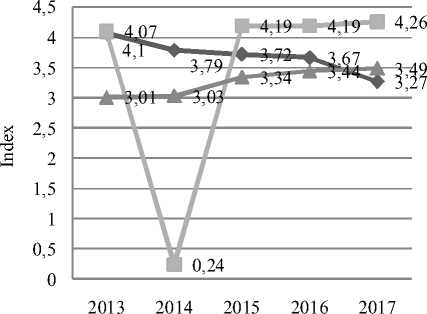
♦ Ethiopia
-■- Kenya
—*- Tanzania
Fig. 1. Quality of roads: Ethiopia, Kenya and Tanzania
Note. Source: own calculation, World Bank, World Economic Forum Global Competitiveness Index.
construction and maintenance of airports and all the systems linked to it. It is one of the world’s most important and technologically advanced modes of transportation with significant contribution to countries economic growth. Availability of good quality air transport easies the flow of goods and services by providing very speedy connections between regions, countries, and cities. Several Studies [Brueckner, 2003; Bloom, Sachs, 1998; Green, 2007; Mehmood, Shahid, 2014; Shepherd et al., 2016] remarked that the role of air transportation in boosting the economic growth is high. Tourism is a key sector in Kenya, Tanzania and Ethiopia as they have several attraction sites. It is therefore very significant that option is available for comfortable and safe mode of transportation for tourists which is the air transport.
Due to globalization and trade integration across regions, the demand for air transport has been growing rapidly. The increased awareness and development of tourism industry in east African regions has also played significant role in increasing the number of people using the air transport service. This mode of transport is also very important and is preferred by areas where road transport access cannot be easily constructed.
Air transport is operated through bilateral agreement [AFDB, 2012] and hence the African transport sector faces restrictive regulatory barriers. Such barriers are key challenges to the global and regional market integration [Oum et al., 2010]. East African countries are also affected by bilateral air service agreements’ restrictions [Munene, 2012].
As it is indicated by the Fig. 2 above, a positive improvement has been observed by all airlines in increasing their size of departure over the years. Comparing the number of registered departures in the three countries, Kenyan airline has the highest registered departure worldwide over the years followed by Ethiopian airline. Such high numbers of registered departures are an indication of the countries’ number of flights across the globe.
But, this figure is low compared to other regions. The main reason is the air transport system of African countries is one of the main challenges leading them to poor safety record. According to [Handbook on Infrastructure Statistics, 2011], due to old air craft in use, 4.3 aircrafts are lost per 1 million departures in east Africa compared with 0.7 elsewhere. Hence, without a proper system, it is difficult to improve the overall contribution of the airline aviation of the countries.
In Fig. 3 above, the total number passengers that has been using the air transport system has been dramatically increasing over the study period. Although Ethiopian airline is the largest and famous airline in Africa, the number of passengers that are transported via this airline is lower compared to Kenya and Tanzania. Tanzania is leading by the number of passengers carried by their respective air aviation. The low number of passengers carried by the Ethiopian airline is due to its high cost compared to others.
Besides to transporting people, air transport system is a good mode of freight transportation. The importance of air transport to the developing world like east African countries is very crucial as the economy of these countries mainly depends on agriculture and tourism. The export of horticultural products and goods from Ethiopia, Kenya and Tanzania increased the importance of cargo service in these countries, although Ethiopia takes the largest share of cargo services in the region.
On the contrary, to the passengers transported via each country’s air aviation, the Ethiopian airline
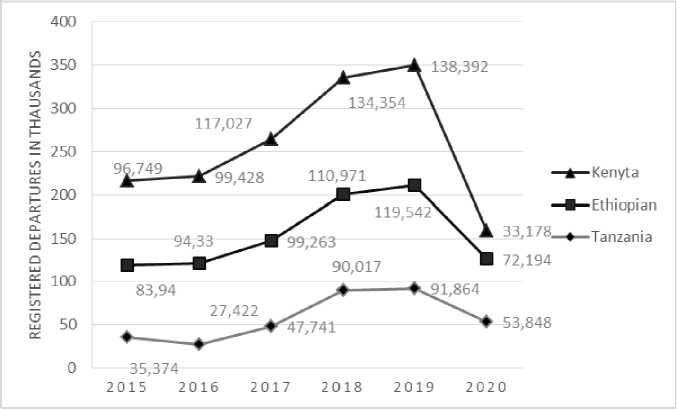
Fig. 2. Air transport registered carrier departures, Ethiopia, Kenya, and Tanzania (2015–2019) Note. Source: Own calculation, World Bank.
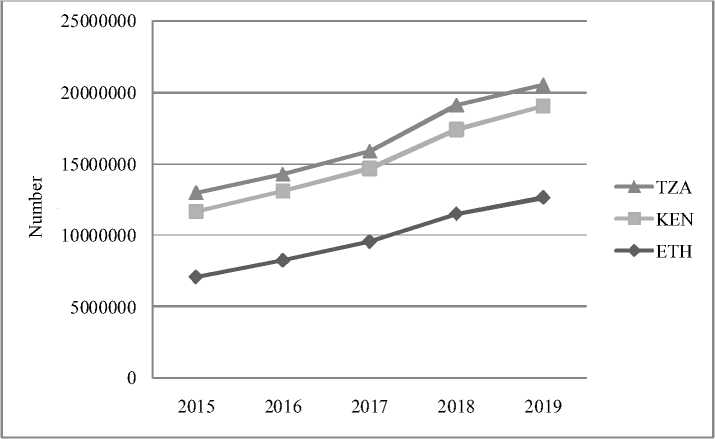
Fig. 3. Changes in number of passengers carried via the Ethiopian, Kenian and Tanzanian airlines over the study period Note. Source: Own calculation, World Bank.
cargo services have increased in a speedy way while Kenya and Tanzania didn’t show much improvement over the study period. As it’s shown in Fig. 4, the total number of tons transported via Ethiopian cargo service in 2018 was over 2000 million ton-km while Kenyan below 500 Million ton-km and no cargo service for Tanzania. This indicates that the Ethiopian air transport in the freight transport system is the key element of the airline’s development. According to one percent, increase in cargo service development is likely to increase the total trade by 6.3 percent [Shepherd et al., 2016]. Therefore, the regional airline should invest on cargo development so that the airlines’ capacity is improved.
The quality of air transport service is indicated in Fig. 5. As it can be observed from the graph, the quality of air transport of Ethiopia was the highest between the years 2009–2014 and suddenly dropped down in the next two years although it started to regain its position. Yet, it’s below the global average quality. On the other hand, Kenyan airways quality has been above the global average since 2009 while Tanzanian airline is still struggling to reach the average global quality.
Air transport has been a significant driver of East Africa’s economy and has been reported to boost economy, serving as regional headquarters of multinational logistics and fostering trade organizations, and foreign direct investment in the
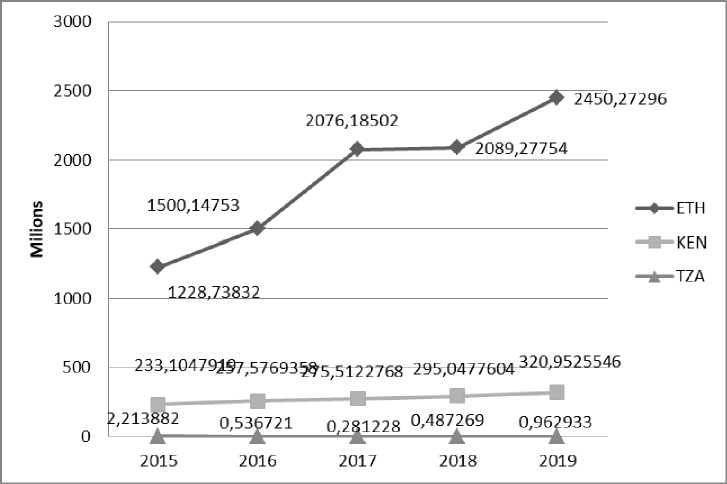
Fig. 4. The total number of tons transported via Ethiopian, Kenian, Tanzanian cargo service over the 2015–2019 period
Note. Source: Own calculation, from World Bank.
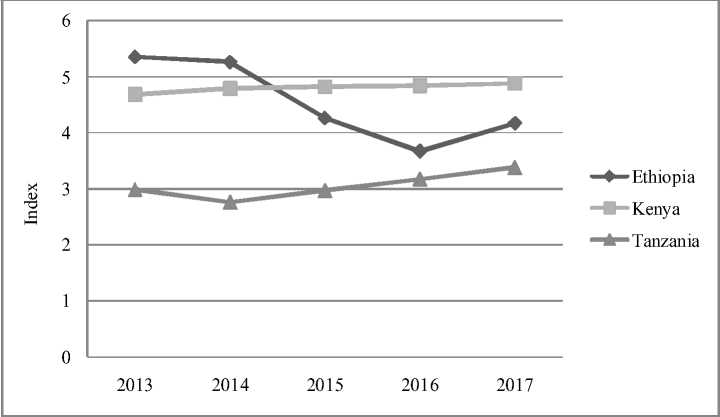
Fig. 5. Quality of Air transport Infrastructure, Index
Note. Source: Own calculation, from World Bank, World Economic Forum Global Competitiveness Index.
country. For instance, in 2017, over 4.7 million international arrivals to Kenya were registered, with aviation and tourism representing USD 3.2 billion of GDP. The aviation sector accounts for 4.6% of Kenya’s GDP and supports 410.000 jobs. With 4.8 million passenger arrivals to Kenya’s airports every year and the country’s established position as the leading cargo hub for East Africa, indeed the aviation sector has impacted significantly to the country [Hu et al., 2015]. Whereas in Ethiopia, the air transport sector contributes more than 60% of the service sector contribution. To revive the airline market in Tanzania, the Government purchased and
Air Tanzania Company Limited (ATLC) began new operations with new Bombardier and Boeing planes. ATLC revenue increased to 4.5 billion at the end of 2017 up from 700 million shillings collected in 2016 and losses cut down to 4.3 billion shillings in 2017 compared to 14.2 billion shillings posted in 2016, signalling that the national carrier is rebounding after a decade of a steady decline.
Conclusion
The presence of well-constructed transport system fuels up the economic development of a country and enhances the regional integration. Although there are several untapped natural resources, Africa at large and the east African region are yet to be developed. There are many reasons to mention for this underdevelopment of the region. Among the reasons, poor transport infrastructure is one and the most important. Transport service plays a significant role in assuring sustainable development through facilitating trade integration across countries. The main aim of this research was to analyse the transport infrastructural status, especially road and air transport system of east African countries Ethiopia, Kenya and Tanzania. These countries were chosen since these countries are among the fast-growing countries in Africa and better environment to develop.
Although there have been improvements on the quality of roads, Kenya’s road transport is above the world median quality compared to Ethiopia and Kenya, which quality is below the world average stated in the global competitiveness index. This indicates that both Ethiopia and Tanzania must improve on the road quality improvement programs. Air Transport one of the comfortable modes of transportation where the number of passengers transported has been increasing over the study period. It eases the flow of goods and services. The Ethiopian cargo system is well developed by far compared to Kenya and Tanzania transporting more than 2 billion tons in 2017. The quality of air transport system of both Kenya and Tanzania is below the world median. With the rising population flow and trade integration, the transport service development needs more attention than ever. Therefore, East African countries should plan and execute on transport infrastructure development projects. In addition to this, common policies should be devised with the focus of planning and implementing cost shared Projects. In addition to this, prioritizing the issue of regional integration and development of harmonized standards will boost the efficiency of the transport quality. Moreover, improving the overall system of the transport infrastructure will play a significant impact on the economic development of the respective countries and the region.
Список литературы East African transport infrastructure: the cases of Ethiopia, Kenya and Tanzania
- Admasu S., Måns S., Eyerusalem S., Getnet A., 2015. Road Infrastructure and Enterprise Dynamics in Ethiopia. The Journal of Development Studies, vol. 51 (11), pp. 1-18. DOI: 10.1080/00220388.2015.1056785. URL: https://www.researchgate.net/publication/282423638_Road_Infrastructure_and_En terprise_Dynamics_in_Ethiopia
- AFDB, 2012. Africa’s Aviation Industry: Challenges and Opportunities. URL: https://blogs.afdb.org/afdbchampioning-inclusive-growth-across-africa/post/africas-aviation-industry-challenges-andopportunities-10025
- Bloom D., Sachs J., 1998. Geography, Demography and Economic Growth in Africa. Brookings Papers on Economic Activity, vol. 2 (1998-2), pp. 207-295. URL: https://www.researchgate.net/publication/200032709_Geography_Demography_and_Economic_Growth_in_Africa Brueckner J. K., 2003. Airline Traffic and Urban Economic Development. Urban Studies, Urban Studies Journal Limited, vol. 40 (8), pp. 1455-1469. DOI: 10.1080/0042098032000094388
- Búr G., Tarrósy I., 2011. Az afrikai vándorlás hátteréről és jellemzőiről. Tarrósy I., Keserű D., Glied V., eds. Új népvándorlás. Migráció a 21. században Afrika és Európa között. ID Research Kft. & Publikon Publ., pp. 99-114. URL: http://ittvagyunk.eu/application/essay/127_1.pdf
- Conceiçăo P., 2019. Human Development Report 2019. Beyond Income, Beyond Averages, Beyond Today: Inequalities in Human Development in the 21st Century. URL: https://gtmarket.ru/files/research/human-development-index/Human_Development_Report_2019.pdf? ysclid=l6m71mwinc278225929
- Eynon J., 2016. Construction manager’s BIM Handbook. John Wiley & Sons Ltd. URL: https://onlinelibrary.wiley.com/doi/pdf/10.1002/9781119163 404.fmatter
- Faiz A., 2012. The Promise of Rural Roads: Review of the Role of Low-Volume Roads in Rural Connectivity, Poverty Reduction, Crisis Management, and Liveability. Transportation Research Circular, no. E-C167. DOI: https://doi.org/10.17226/22711
- Free Flow: Reaching Water Security through Cooperation, 2013. Paris: UNESCO. URL: http://www.groundwater.com.au/media/W1siZiIsIjIwMTMvMTEvMTAvMjNfMjFfMDFfNV9VTkVTQ09fRnJlZUZsb3dfMjAxMy5wZGYiXV0/UNESCO_FreeFlow_2013.pdf
- Frone S., Frone D., 2014. Challenges in Analyzing Correlation Between Water Infrastructure and Economic Development. Conference: International Conference on Applied Statistics (ICAS) 2013. At: Bucharest Volume: Procedia Economics and Finance, vol. 10, pp. 197-206. DOI: 10.1016/S2212-5671(14)00294-9
- Green R.K., 2007. Airports and Economic Development. Real Estate Economics, vol. 35 (1), pp. 91-112. DOI: https://doi.org/10.1111/j.1540-6229.2007.00183.x
- Handbook on Infrastructure Statistics, 2011. Africa Infrastructure Knowledge Program. December. 243 p. URL: https://www.afdb.org/fileadmin/uploads/afdb/Documents/Publications/AfDB%20Infrastructure_web.pdf
- Hoyle B.S., Knowles R., ed., 1999. Modern Transport Geography, 2nd Edition. S.l., Wiley. 382 p.
- Hu Y., Xiao J., Deng Y., Xiao Y., Wang S., 2015. Domestic Air Passenger Traffic and Economic Growth in China: Evidence from Heterogeneous Panel Models. Journal of Air Transport Management, vol. 42, pp. 95-100. DOI: 10.1016/j.jairtraman.2014.09.003
- Ismail N.W., Mahyideen J.M., 2015. The Impact of Infrastructure on Trade and Economic Growth in Selected Economies in Asia. ADBI Working Paper 553. Tokyo, Asian Development Bank Institute. URL: http://www.adb.org/publications/impactinfrastructure-trade-and-economic-growth-selectedeconomies-asia
- Káposzta J., Ritter K., Nagy H., 2016. Local Economic Development in Transition Economies: A Tool for Sustainable Development of Rural Areas. Erokhin V., ed. Global Perspectives on Trade Integration and Economies in Transition. Hershey (PA), IGI Global, pp. 281-298. DOI: 10.4018/978-1-7998-2448-0.ch022
- Mahembe E., Odhiambo N.M., 2014. Foreign Direct Investment and Economic Growth: A Theoretical Framework. Journal of Governance and Regulation, vol. 3 (2), pp. 63-70. DOI: 10.22495/jgr_v3_i2_p6
- Meersman H., Nazemzadeh M., 2017. The Contribution of Transport Infrastructure to Economic Activity: The Case of Belgium. Case Studies on Transport Policy, vol. 5 (2), pp. 316-324. DOI: https://doi.org/10.1016/j.cstp.2017.03.009
- Mehmood B., Shahid A., 2014. Aviation Demand and Economic Growth in the Czech Republic: Co Integration Estimation and Causality Analysis. Statistika: Statistics & Economy Journal, vol. 94 (1), pp. 54-63. URL: https://www.czso.cz/documents/10180/25609555/32019714q1054.pdf/44f5db22-9073-4708-a4d2-11dd8d2657ee?version=1.0
- Munene M.N., 2012. Liberalization of Air Transport in Africa: Case of Kenya’s Air Transport. A Research Project Submitted in Partial Fulfillment of the Degree of Master of Arts in International, Studies, University of Nairobi University of Nairobi Institute of Diplomacy and International Studies. URL: Liberalization of Air Transport in Africa: Case of Kenya’s Air Transport (uonbi.ac.ke)
- Nagy H., Neszmélyi G.I., Káposzta J., Obozuwa O.G., 2017. Effects of International Trade Agreements on the Economy and Society of Africa: Special Focus on Nigeria. Erokhin V., ed. Establishing Food Security and Alternatives to International Trade in Emerging Economies. Hershey (PA), IGI Global, pp. 196-219. DOI: 10.4018/978-1-5225-2733-6.ch010
- Nahman A., Wise R., Lange W., 2009. Environmental and Resource Economics in South Africa: Status Quo and Lessons for Developing Countries. South African Journal of Science, vol. 105, no. 9-10, pp. 350-355. DOI: 10.4102/sajs.v105i9/10.108
- Ngezahayo E., Ghataora G.S., Burrow M.P.N., 2019. Factors Affecting Erosion in Unpaved Roads. Proceedings of the 4th World Congress on Civil, Structural, and Environmental Engineering (CSEE’19). Rome, Italy. Apr. 7–9, 2019. Paper No. ICGRE 108. DOI: 10.11159/icgre19.108
- Nijkamp P., 2000. Infrastructure and Suprastructure in Regional Competition: A Deus ex Machina? Batey P.W.J., Friedrich P., eds. Regional Competition. Advances in Spatial Science. Springer, Berlin, Heidelberg. DOI: https://doi.org/10.1007/978-3-662-04234-2_4
- Osakwe P., Santos-Paulino A., Dogan B., 2018. Trade Dependence, Liberalization, and Exports Diversification in Developing Countries. Journal of African Trade, vol. 5, no. 1-2, pp. 19-34. DOI: 10.1016/j.joat.2018.09.001
- Oum T., Zhang A., Fu X., 2010. Air Transport liberalization and Its Impacts on Airline Competition and Air Passenger Traffic. Transportation Journal, vol. 49 (4), pp. 24-41. DOI: 10.2307/40904912
- Petts R., 2013. How Much Should Developing Countries Spend on Road Maintenance? Briefing Note, Intech Asset Management, UK & AFCAP Steering Group. URL: http://ric.works.go.ug/rc/files/4.11_Developing_countries_spend_road_maintenance.pdf
- Pradhan R. P. I., Bagchi T. P., 2013. Effect of Transportation Infrastructure on Economic Growth in India: The VECM Approach. Research in Transportation Economics, vol. 38 (1), pp. 139-148. DOI: 10.1016/j.retrec.2012.05.008
- Prud’homme R., 2004. Infrastructure and Development. Paper prepared ABCDE (Annual Bank Conference on Development Economics). Washington DC, May 3–5.
- Redding S.J., Turner M.A., 2014. Transportation Costs and the Spatial Organization of Economic Activity. National Bureau of Economic Research. Working paper No. 20235. Cambridge. URL: https://www.nber.org/system/files/working_papers/w20235/w20235.pdf
- Robinson H., Bamford C.G., 1978. Geography of Transport. Plymouth, Macdonald and Evans. 430 p. URL: Geography of Transport: by Robinson, H. and Bamford, C. G: (1978) | Naomi Symes Books PBFA (abebooks.com)
- Rostow W.W., 1960. The Stages of Economic Growth. Cambridge, Cambridge University Press. DOI: 10.1017/cbo9780511625824.011
- Sahoo P., Dash R.K., Nataraj G., 2012. China’s Growth Story: The Role of Physical and Social Infrastructure. Journal of Economic Development, vol. 37 (1), pp. 53-75. DOI: 10.35866/CAUJED.2012.37.1.003
- Shepherd B., Shingal A., Raj A., 2016. Value of Air Cargo: Air Transport and Global Value Chains Final Report. 97. International Air Transport Association (IATA). URL: value-of-air-cargo-2016-report.pdf (iata.org)
- Shiferaw A., 2017. Productive Capacity and Economic Growth in Ethiopia, New York City, United Nations Department of Economics and Social Affairs. CDP Background Paper, no. 34. URL: https://www.un.org/development/desa/dpad/wp-content/uploads/sites/45/publication/CDP-bp-2017-34.pdf
- Srinivasu B., Srinivasa-Rao P., 2013. Infrastructure Development and Economic growth: Prospects and Perspective. Journal of Business Management & Social Sciences Research, vol. 2 (1), pp. 81-91.
- Taaffe E., Gauthier H., 1973. Geography of Transportation. Prentice-Hall, New Jersey. URL: Geography of transportation (Book, 1973) [WorldCat.org].
- Tarrósy I., 2009. Politikai elméletek és módszertanok a mai afrikai problémák megértéséhez. Csizmadia S., Tarrósy I., eds. Afrika Ma – Tradíció, Átalakulás, Fejlődés. Pécs, ID Research Kft. & Publikon Publishing, pp. 13-17. URL: http://www.publikon.hu/userfiles/File/afrikama_f1.pdf
- Teklebirhan A., 2015. Public Infrastructure Investment, Private Investment and Economic Growth in Ethiopia: Co-Integrated VAR Approach. Addis Ababa, Addis Ababa University. URL: https://scholar.archive.org/work/sdws4addxnby5hcbw2sxaweisi
- United Nations, 2017. Revisions of World Populations Prospects, Department of Economics and Social Affairs of the UN Secretariat. URL: World Population Prospects: The 2017 Revision | Multimedia Library – United Nations Department of Economic and Social Affairs.
- World Bank Project Appraisal Document, 2003. Ethiopia – Second Road Sector Development Program Project World Bank, Chicago, 2003. URL: http://documents.worldbank.org/curated/en/693901468 770964529/Ethiopia-Second-Road-Sector-Development-Program-Project
- World Bank, 2008. Safe, Clean and Affordable Transport for Development. The WB Group’s Transport Business Strategy 2008–2012. URL: Safe, clean, and affordable...transport for development: the World Bank Group’s transport business strategy for 2008-2012.
- Wu J., Deng Y., Huang J., Morck R., Yeung B., 2013. Incentives and Outcomes: China’s Environmental Policy. Capitalism and Society, vol. 9 (1), pp. 1-41. DOI: 10.2139/ssrn.2206043
- Zheng D., Kuroda T., 2013. The Role of Public Infrastructure in China’s Regional Inequality and Growth: A Simultaneous Equations Approach. The Developing Economies, vol. 51, iss. 1, pp. 79-109. DOI: 10.1111/deve.2013.51.issue-1

